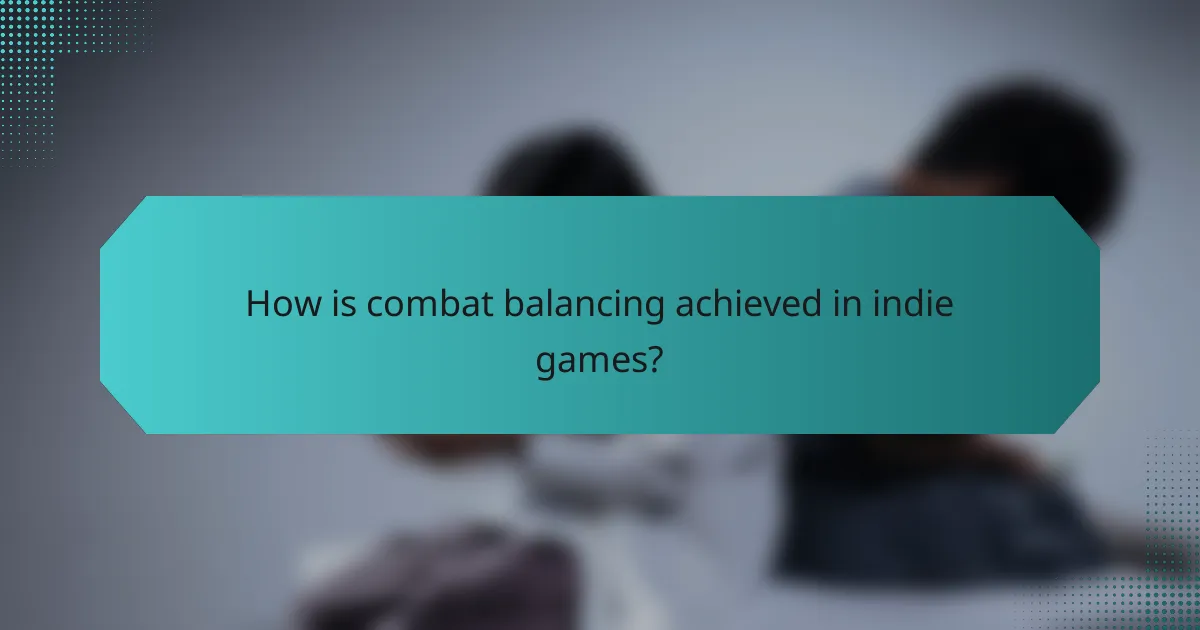Combat systems in indie fantasy adventure games significantly impact player engagement and overall experience. Key styles include real-time action, turn-based strategy, and hybrid systems. Balancing these mechanics involves iterative testing, adaptive difficulty, and player feedback. Unique features like customizable skill trees and dynamic AI further enhance immersion and strategy.

What are the key combat styles in indie fantasy adventure games?
Key combat styles in indie fantasy adventure games include real-time action, turn-based strategy, and hybrid systems. Real-time action emphasizes quick reflexes and skill-based gameplay, while turn-based strategy focuses on tactical decision-making and planning. Hybrid systems combine elements of both, offering players flexibility in combat approach. Each style influences player engagement and game balance, shaping the overall experience.
How do melee combat systems vary across different games?
Melee combat systems vary significantly across indie fantasy adventure games, focusing on styles, balancing, and player engagement. Different games may feature real-time combat, turn-based mechanics, or hybrid systems, each offering unique player experiences.
For example, real-time combat often emphasizes reflexes and timing, while turn-based systems allow for strategic planning. Balancing these systems involves adjusting damage output, cooldowns, and enemy AI to enhance player engagement. Unique attributes, such as combo systems or weapon customization, can further differentiate combat styles, providing players with varied approaches to encounters.
Indie games often experiment with innovative mechanics, leading to rare attributes like environmental interactions or rhythm-based attacks, which can create memorable gameplay experiences. Overall, the diversity in melee combat systems enriches the indie fantasy adventure genre, catering to different player preferences and playstyles.
What role does ranged combat play in player strategy?
Ranged combat significantly enhances player strategy by offering versatility and tactical options. Players can engage enemies from a distance, allowing them to control the battlefield and minimize risk. This style of combat encourages strategic positioning, resource management, and the use of environmental cover. Additionally, ranged weapons often feature unique attributes, such as varying damage types and effects, which can influence player choices and engagement dynamics. The integration of ranged combat in indie fantasy adventure games fosters deeper player engagement through these strategic layers.
How are magic systems integrated into combat mechanics?
Magic systems enhance combat mechanics by providing unique abilities and strategies. They introduce diverse play styles, allowing players to combine magic with physical attacks. This integration fosters engagement through tactical decision-making and resource management. Balancing these systems is crucial; overpowered magic can disrupt gameplay. Effective design ensures that magic complements combat without overshadowing it.

How is combat balancing achieved in indie games?
Combat balancing in indie games is achieved through iterative testing, player feedback, and adaptive difficulty systems. Developers often focus on core mechanics to ensure fairness and engagement.
Balancing involves adjusting damage output, enemy health, and player abilities. This is often done via playtesting sessions where developers gather data on player performance and satisfaction.
Adaptive difficulty systems dynamically adjust challenges based on player skill, enhancing engagement and reducing frustration. This approach fosters a more personalized gaming experience.
Incorporating player choice in combat styles also contributes to balance. Allowing players to select different approaches can lead to varied gameplay experiences, catering to diverse preferences and skill levels.
What metrics are used to evaluate combat effectiveness?
Combat effectiveness in indie fantasy adventure games is evaluated using metrics like damage output, accuracy, and player survivability. These metrics assess how well combat systems balance player engagement and challenge.
| Metric | Description | Value Example |
|———————-|————————————–|———————|
| Damage Output | Total damage inflicted per action | 150 damage |
| Accuracy | Percentage of successful hits | 85% hit rate |
| Player Survivability | Average health remaining post-combat | 30% health left |
| Skill Cooldown | Time required before skills can be reused | 10 seconds |
| Enemy Difficulty | Level of challenge posed by enemies | Medium |
| Engagement Level | Player satisfaction during combat | High |
How do developers address overpowered abilities?
Developers address overpowered abilities by implementing balancing mechanics. They may adjust damage output, cooldown times, or resource costs to ensure fair gameplay. Playtesting is crucial; feedback helps identify imbalances. Developers also utilize player data analytics to track ability usage and effectiveness, allowing for informed adjustments. Regular updates keep the game dynamic and responsive to community needs.
What are common balancing challenges faced by indie developers?
Indie developers often face balancing challenges in combat systems, including difficulty in tuning difficulty levels, ensuring player engagement, and managing resource allocation. These issues can lead to player frustration or disengagement if not addressed effectively.
Common challenges include:
– Difficulty tuning enemy strength and behavior
– Balancing player abilities and progression
– Ensuring diverse combat styles appeal to various players
– Managing player feedback to refine gameplay mechanics
– Addressing performance issues on different platforms
– Maintaining a consistent experience without overwhelming players

How do player engagement strategies influence combat systems?
Player engagement strategies significantly enhance combat systems by creating immersive experiences. These strategies include dynamic difficulty adjustments, responsive AI, and player feedback mechanisms that cater to individual skill levels.
For instance, dynamic difficulty ensures that combat remains challenging yet achievable, maintaining player interest. Responsive AI adapts to player actions, making encounters feel unique and engaging. Additionally, incorporating player feedback allows developers to refine combat mechanics, ensuring they align with player expectations and preferences.
Ultimately, these strategies foster a deeper connection between players and the game, enhancing satisfaction and replayability.
Why is feedback important in combat design?
Feedback is crucial in combat design as it enhances gameplay balance and player engagement. It allows developers to understand player experiences, identify issues, and refine mechanics. Continuous feedback leads to improved combat systems that resonate with players, fostering a more immersive adventure. Engaging players in the design process can yield unique insights, ensuring the combat experience aligns with their expectations and preferences.
How do rewards and progression systems impact player motivation?
Rewards and progression systems significantly enhance player motivation by providing clear goals and a sense of achievement. These systems encourage continued engagement through incremental challenges and rewards that align with player preferences. For example, in indie fantasy adventure games, unique combat styles can offer specific rewards, such as skill upgrades or new abilities, which motivate players to explore and improve. Balancing these systems is crucial; players must feel challenged yet capable, ensuring sustained interest and enjoyment. Ultimately, effective rewards and progression systems foster a deeper connection between players and the game, enhancing overall engagement.
What community-driven elements enhance combat experiences?
Community-driven elements enhance combat experiences by fostering collaboration, feedback, and shared strategies among players. These elements include player-created content, community events, and forums for discussion. Engaging with a community can lead to improved balance in combat systems as players share insights and suggestions. Additionally, player feedback can help developers refine mechanics, ensuring a more enjoyable combat experience.

Which unique mechanics set certain indie games apart?
Unique mechanics in indie fantasy adventure games often include innovative combat systems that enhance player engagement. These systems may feature real-time action, turn-based strategies, or hybrid approaches, each offering distinct styles that cater to various player preferences. Balancing these mechanics is crucial; developers focus on creating rewarding experiences that challenge players without causing frustration. Unique attributes, such as customizable skill trees or environmental interactions, can further set these games apart, fostering deeper immersion and strategic depth.
What innovative approaches to combat have emerged in recent titles?
Innovative approaches in recent indie fantasy adventure games include dynamic combat systems that adapt to player choices and environmental interactions. Many titles now feature real-time strategy elements, allowing players to combine skills and tactics fluidly. Unique mechanics, such as rhythm-based attacks and collaborative multiplayer combat, enhance player engagement. Additionally, some games incorporate procedural generation to create varied combat scenarios, ensuring that each encounter feels fresh and challenging. These innovations reflect a shift towards more immersive and interactive gameplay experiences.
How do narrative elements intertwine with combat mechanics?
Narrative elements enhance combat mechanics by providing context and emotional stakes. They shape player decisions, making combat feel meaningful. For instance, character backstories can influence fighting styles, while plot developments may introduce unique combat challenges. This integration fosters deeper player engagement and investment in outcomes.

What are the rare attributes that enhance combat immersion?
Rare attributes that enhance combat immersion include environmental interactions, dynamic enemy AI, and customizable combat styles. These elements create unique experiences, allowing players to engage deeply with the game world. Environmental interactions, such as destructible terrain, can alter strategies. Dynamic enemy AI adapts to player actions, making encounters unpredictable. Customizable combat styles enable players to tailor their approach, enhancing personal investment in gameplay.
How does environmental interaction affect combat dynamics?
Environmental interaction significantly influences combat dynamics by altering player strategies and engagement levels. Terrain, weather, and obstacles can enhance or hinder combat effectiveness. For instance, high ground provides tactical advantages, while dense forests may obstruct visibility. Dynamic environments encourage players to adapt, creating more immersive gameplay experiences. Unique attributes like destructible environments can further impact tactics, allowing for creative solutions in combat scenarios. As a result, these interactions deepen player engagement and satisfaction in indie fantasy adventure games.
What role do player choices play in shaping combat outcomes?
Player choices significantly influence combat outcomes by determining strategy, resource allocation, and character development. Decisions such as skill selection, equipment management, and tactical positioning directly affect combat effectiveness. For example, choosing a defensive skill over an offensive one can lead to a more sustainable approach in battles. This choice impacts not only immediate combat results but also long-term character progression and player engagement. In indie fantasy adventure games, where player agency is emphasized, these choices enhance the overall experience and replayability.

What best practices should developers follow for effective combat systems?
Developers should prioritize player feedback, balance combat mechanics, and ensure intuitive controls for effective combat systems. Engaging players requires a variety of combat styles, allowing for strategic choices. Regular playtesting helps identify issues and refine gameplay. Incorporating unique attributes, like character abilities, enhances player engagement and satisfaction.